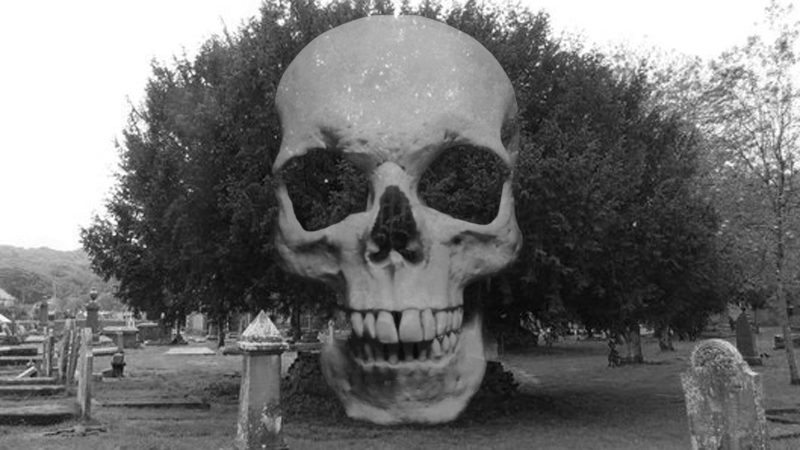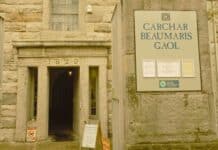The dictionary defines a curse as “a solemn utterance intended to invoke a supernatural power to inflict harm or punishment on someone or something”. To reverse or eliminate a curse is sometimes called “removal” or “breaking,” and is often believed to require intricate rituals or prayers. Here CLAIRE BARRAND lists five deadly Welsh curses embraced in times gone by.

Welsh Curses
Curse of the Raglan Castle Owl
In Celtic mythology, the owl was a sign of the underworld. Its cry is said to signal approaching death and misfortune. The owl was linked to the dead and called the ‘Night Hag.’
In the 19th century in Cwmcarvan, an extraordinarily large white owl was often spotted over an ancient battlefield, leading inhabitants to believe the bird was magical and should never be disturbed. One day, however, a visitor to Raglan Castle mocked the story and slaughtered the owl, only to die a few hours later, choking to death at a dinner table.
Curse of the Screaming Skull, Flacgnallt Hall
A screaming skull is a human skull which legend says, speaks, screams, or haunts its surroundings. In Holywell (Clwyd), Flacgnallt Hall, the skull of “Dafydd” Prince of Wales is contained in a box in the hall. A curse is said to affect the proprietors of the building should the skull ever removed from the property. The last time it was removed, the person accountable was plagued by shadowy figures and screams – they promptly returned the skull, and the visions stopped.
Cursing Wells
Wells have been commonly used to curse people, and this practice goes back to Roman times, possibly earlier.
There are two wells in North Wales that both have a reputation for double use, both for cursing and for healing. One is at Llaneilian on Anglesey, the other Ffynnon Elian, is in Llanelian in Rhos, although cursing at wells was a widespread business.
A fee would be paid to the guardian of the well, to engrave the name of the cursed onto a slate with a pin; which would then be bent and thrown into the well. The typical witch’s method of making a dummy of the person to be cursed and piercing of drowning the dummy was also carried out. A more gruesome approach a live frog was pierced with a skewer, to which was attached two corks. The frog was then floated on the water of the well and so long as the Frog lived the person cursed would suffer.
The rituals for lifting curses were likewise involved, and comprised a reading of Psalms and other Bible scripts, walking three times round the well, and the draining of the well by the guardian so that the lead and slate could be found and removed. Occasionally the slate was ground into dust, mixed with salt, and burned on the fire. The victim also had to take some well water home and drink it, while reading Psalms.
Yew Trees and Ancient Curses
The yew tree is a native tree to Wales, and the UK. Yew has long been a tree that has been held sacred by the Druids in pre-Christian times.
The tree has qualities of longevity and regeneration (as trailing branches of old yew trees can root and sprout baby trees where they touch the ground), so the yew came to represent death and rebirth in Celtic culture.
The superstitious belief was that anyone chopping a yew tree down would suffer an ancient curse – or even eternal damnation. An old curse goes as follows:
“Well of the Yew Tree, Well of the Yew Tree,
To thee should honour be given;
In Hell, a bed is ready for him
Who cuts the tree about thine ears.”
Witches of Llanddona
Anglesey folklore tells of a boat of witches which arrived on the shore. They had been cast out by their community for their wicked practices. The locals tried to drive them back into the sea, but they witnessed one, who weak from thirst and hunger, ordered a spring of pure water to burst forth on the sands, and it did. The strangers were allowed to stay, but they continued their evil ways, and the parish developed a reputation. “Witches of Llanddona” was a term that became unfairly applied to all the females of the parish. Bella Fawr, “Big Bella” was known to be the worst of them all, and she would curse milk so that it would not turn to butter. They would chant the following at anyone who crossed them ;
“May he wander for ages many,
And at every step, a stile,
At every stile, a fall;
At every fall, a broken bone,
Not the largest nor the least bone,
But the chief neck bone, every time”.
Today in parts of Llanddona, It is said to this day that the witching abilities belong to some families, and inherited from mothers to daughters.
What do you think of these Welsh curses? Tell us in the comments section below!







